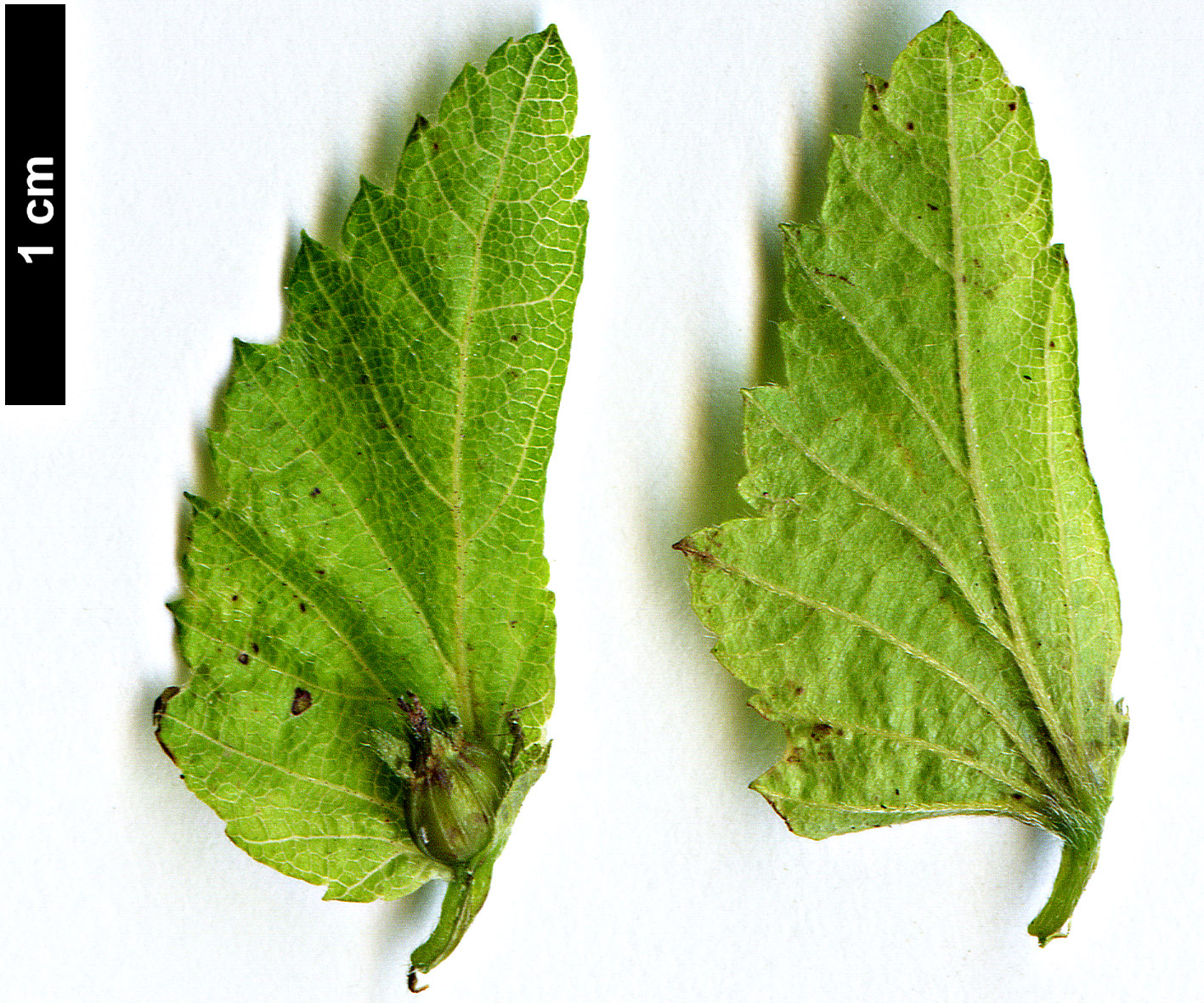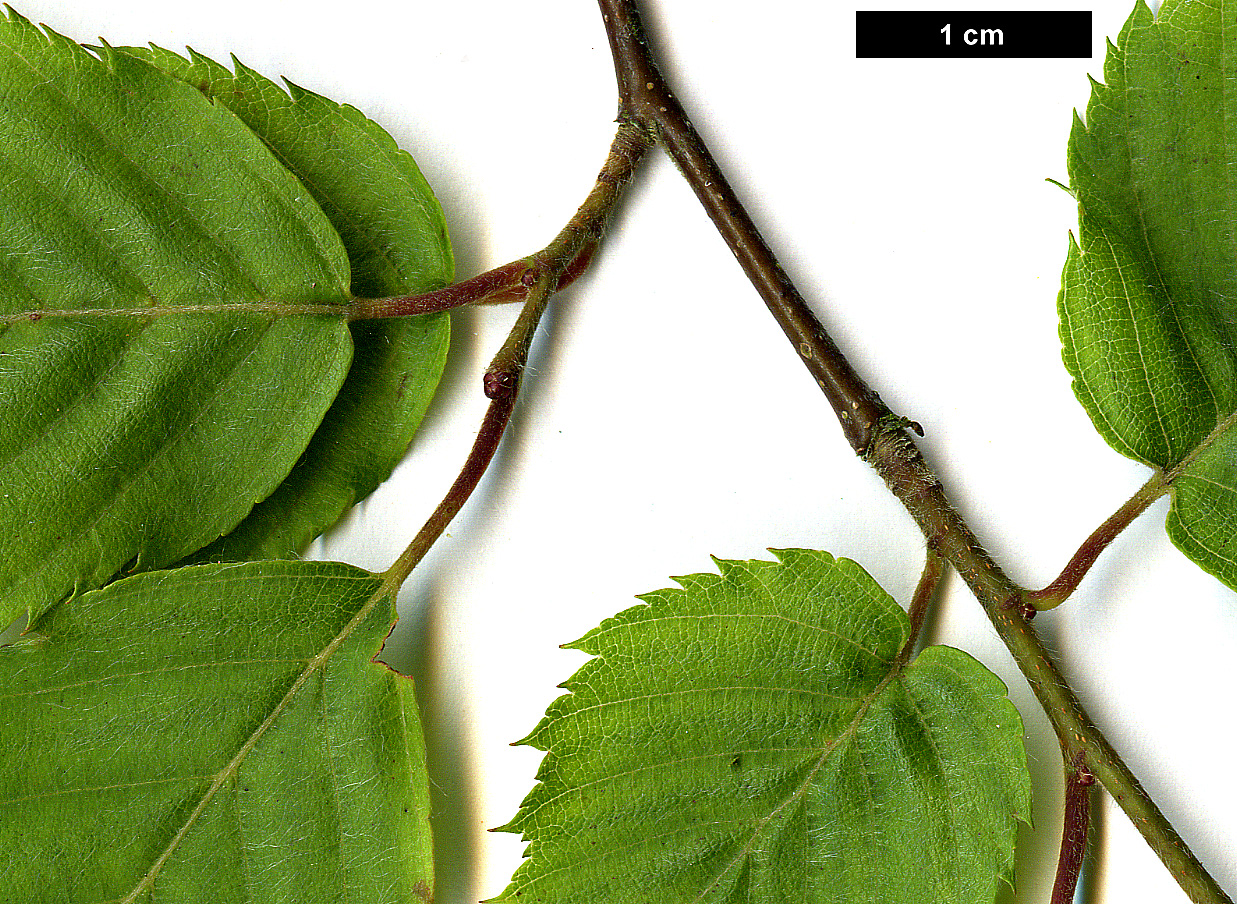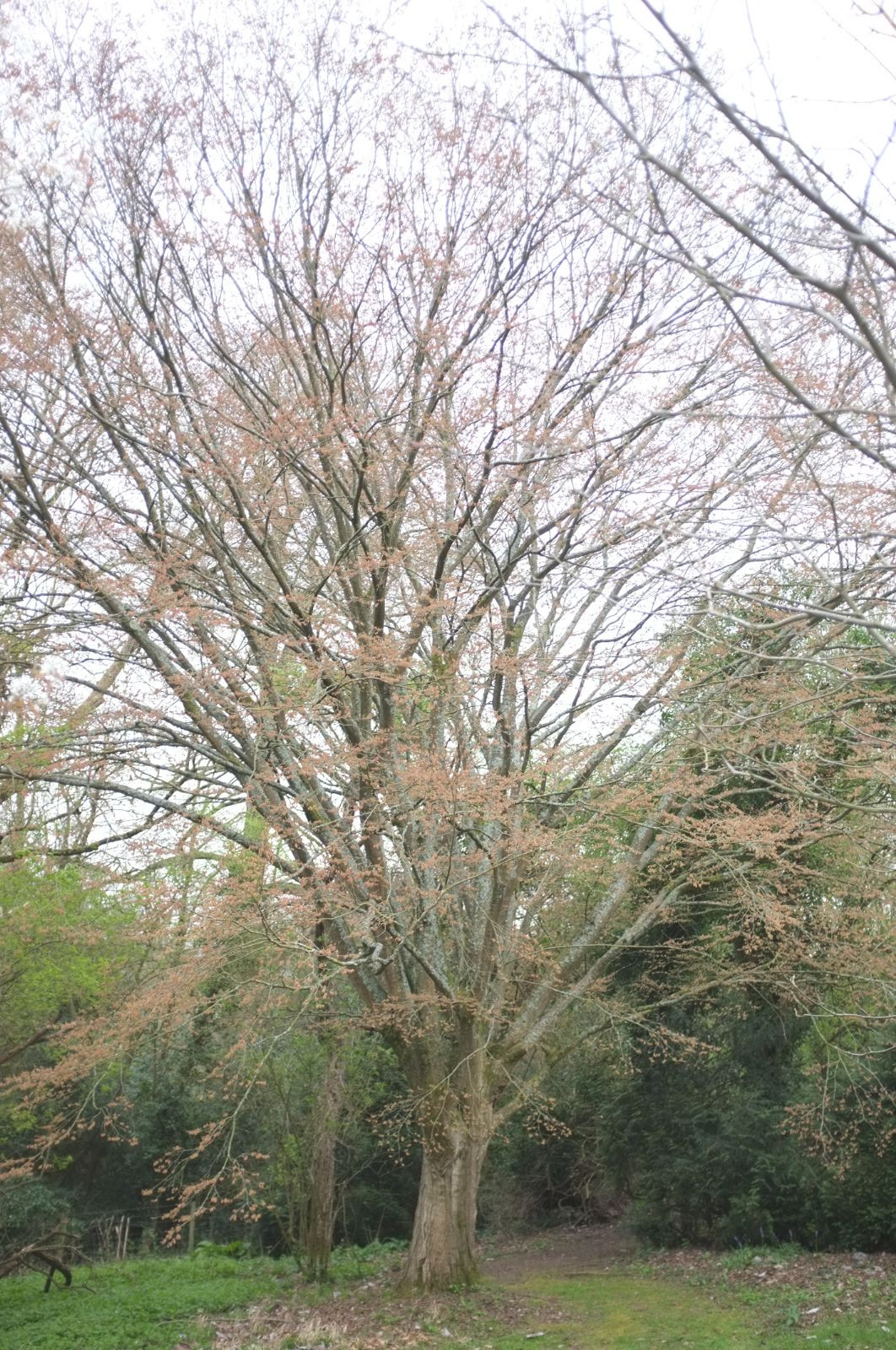Carpinus fargesiana
Sponsor
Kindly sponsored by
Lord and Lady Aldington
Credits
Owen Johnson (2022)
Recommended citation
Johnson, O. (2022), 'Carpinus fargesiana' from the website Trees and Shrubs Online (treesandshrubsonline.
Genus
Synonyms
- Carpinus daginensis Hu
Infraspecifics
Other taxa in genus
- Carpinus betulus
- Carpinus caroliniana
- Carpinus cordata
- Carpinus faginea
- Carpinus fangiana
- Carpinus hebestroma
- Carpinus henryana
- Carpinus japonica
- Carpinus kawakamii
- Carpinus laxiflora
- Carpinus londoniana
- Carpinus mollicoma
- Carpinus monbeigiana
- Carpinus omeiensis
- Carpinus orientalis
- Carpinus polyneura
- Carpinus pubescens
- Carpinus rankanensis
- Carpinus × schuschaensis
- Carpinus shensiensis
- Carpinus tropicalis
- Carpinus tschonoskii
- Carpinus turczaninovii
- Carpinus viminea
Tree to 20 m. Bark grey, smooth with some fissures in maturity. Branchlets dark brown to grey, sparsely pubescent. Leaves ovate to oblong to broadly lanceolate, 3.5–7.5 × 2–2.5 cm; base rounded to cordate; apex often long-pointed; with hairs along the veins when young and tufts under the vein-axils; lateral veins in 12–16 pairs, impressed; margins irregularly double-serrate, teeth blunt or mucronate; flushing bronze to purplish; petiole sparsely hairy, 6–10 mm. Female catkin 4–7 cm long in fruit; peduncle sparsely hairy; bracts D-shaped, the straight side entire and with an auricle at the base folded over the nutlet, the curved side irregularly dentate-serrate to lobulate but not lobed. Nutlet glabrous except for some hairs at the tip. (Li & Skvortsov 1999; Clarke 1988).
Distribution China S Gansu, W Hebei, W Henan, S Shaanxi, Sichuan Vietnam In mountains in the far north of the country
Habitat Mountain valleys and streambanks, 1000–2600 m asl.
USDA Hardiness Zone 7
RHS Hardiness Rating H5
Conservation status Least concern (LC)
Carpinus fargesiana is part of an extensive group of largely Chinese hornbeams which are too closely related for genetic analysis to be a reliable tool, yet, in separating them (Dong et al. 2022); the earliest available name for a plant in this group is C. turczaninovii Hance (1868). The name C. fargesiana was published by H.J.P. Winkler in 1914 and commemorates the French missionary priest and botanist Paul Farges, who collected material in the late 19th century. (It should not be confused with C. fargesii, described by Adrien Franchet in 1899 and now usually considered a synonym for the rather distantly related C. viminea.)
To attempt to differentiate this group of taxa using macroscopic features is, obviously, an imprecise art, and it seems better to regard the various published names as flags of convenience rather than as clearly defined entities. Carpinus turczaninovii itself has a wider and more northerly distribution, extending to Korea and Japan, and its leaves generally carry fewer (8–13) pairs of lateral veins. In cultivation in the west, plants grown as C. turczaninovii also tend to have smaller, shorter-pointed leaves which are less corrugated in texture; the leaves of specimens grown as C. fargesiana show brighter reds and purples as they flush, a pointer towards this taxon’s relatively high-altitude, low-latitude origins. Desmond Clarke (Clarke 1988) also comments on the similarity of C. fargesiana in cultivation to C. tschonoskii, another east Asian species which does not, in fact, seem to be closely related (Dong et al. 2022), despite the scarcely distinguishable shape of the fruit-bract. The leaves of C. tschonoskii tend to be slightly larger and shorter-pointed; Clarke suggests that the marginal teeth of C. fargesiana are blunt rather than minutely whisker-tipped, but this is not a consistent feature within wild populations (Li & Skvortsov 1999).
Naming infraspecific taxa within such an ill-defined group of species might be considered unwise. Flora of China (Li & Skvortsov 1999) distinguishes var. fargesiana and var. hwai (Hu & W.C. Cheng) P.C. Li, although the only implied difference is that var. hwai has slightly slenderer, lanceolate leaves. In their recent taxonomic checklist of Carpinus Holstein & Weigend (2017) conflate the latter taxon with the plant described by H.J.P. Winkler in 1914 as C. turczaninovii var. ovalifolia, and publish the new combination C. fargesiana var. ovalifolia. Largely for the sake of consistency, theirs is the nomenclature followed in this account; according to this system, C. fargesiana has been in cultivation in the UK continuously since 1889, and all of the older plants belong to var. ovalifolia.
Var. fargesiana – which has a considerably wider distribution in China itself – has been collected several times since the 1990s. A single mature tree at Kew (1973.19660) was considered by Keith Rushforth (Rushforth 1985) to belong to this variety, but was lost some time after 2001 (Tree Register 2022). Rushforth’s own collection KR 8780 was made in Hà Giang province in northern Vietnam, extending the distribution given in Flora of China (Li & Skvortsov 1999). Seedlings from KR 8780 are now sold in the UK by Pan-Global Plants (Pan-Global Plants 2022); Pan-Global also offers plants from SBG 93/24, which have thrived as far north as Howick Hall in Northumberland, reaching 8 m by 2019 (Tree Register 2022). The largest of these young examples of var. fargesiana, in the same year, was 9 m × 34 cm at 70 cm, in Maurice Foster’s arboretum in Kent (Tree Register 2022). Another collection – SICH 2058, made within a failed conifer plantation in the Gwangwu Shan of Sichuan in 1999 (Grimshaw & Bayton 2009) – has also reached 8 m in quite dense shade at Wakehurst Place in West Sussex (Tree Register 2022). These plants share the elegance of many oriental Carpinus, with rather weeping branches (Grimshaw & Bayton 2009).
The taxon seems little known in cultivation outside the UK. It is offered by Pépinière des Avettes in France (Pépinière des Avettes 2022) and is grown at the J.C. Raulston Arboretum in North Carolina (J.C. Raulston Arboretum 2022), but plants collected in the Emei Shan were not reliably hardy at the Rogów Arboretum in Poland (P. Banaszczak, pers. comm. to John Grimshaw in 2007).
var. ovalifolia (H.J.P. Winkl.) Holstein & Weigend
Synonyms
Carpinus turczaninovii var. ovalifolia H.J.P. Winkl.
Carpinus hwai Hu & W.C. Cheng
Carpinus fargesiana var. hwai (Hu & W.C. Cheng) P.C. Li
Leaves narrowly lanceolate or narrowly oblong, 7–8 × 2–2.2 cm. (Li & Skvortsov 1999).
Distribution
- China – W Hubei (Lichuan Xian), E Sichuan (Wan Xian)
RHS Hardiness Rating: H5
USDA Hardiness Zone: 7
Carpinus fargesiana var. ovalifolia is a very new name for a plant which has been cultivated in the west for well over a century, and whose representatives have been placed under a variety of combinations as each was published. (For a further discussion, see C. fargesiana var. fargesiana, above). In China, the form appears to have a rather restricted distribution, but its taxonomy remains too fluid for it to be clear whether it is threatened. Seed and specimens from a tree of this sort were collected, in eastern Sichuan in 1889, by Augustine Henry, and grown in the hornbeam collection at Kew; this tree was lost some time after 1967, when it was 11.5 m × 18 cm dbh (Tree Register 2022; Rushforth 1985). For a considerable period it was thought to belong within C. polyneura Franch., a hornbeam first described in 1899 with shinier, often glabrous twigs and as many as 20 pairs of lateral veins; it is not, in fact, closely related (Dong et al. 2022).
Several other plants in the UK and Ireland have traditionally been identified as this taxon (for which the name Carpinus turczaninowii var. ovalifolia had become available in 1914). Also in the collection at Kew is a crowded tree from W 4105, collected in the Min River valley in Sichuan in 1910 but only 8 m × 20 cm dbh 112 years later (Tree Register 2022). This collection is the likeliest source for a multi-stemmed 9 m tree at Borde Hill in West Sussex and of another at Dawyck Botanic Garden in the Scottish Borders, and also for much the finest example known in cultivation, which grows in a rich riverine soil at Burford Lodge under Box Hill in Surrey and was planted by Sir Trevor Lawrence, who was President of the Royal Horticultural Society until his death in 1913, or by his son Sir William Lawrence VMH, the RHS’s Treasurer. In 2019 it was a shapely tree of 13 m × 55 cm dbh (Tree Register 2022), with the gracefulness characteristic of most Asiatic hornbeams. Another was added to the collection at Birr Castle in central Ireland in 1943 (Tree Register 2022). The only example to be grown under this name in recent years seems to be one in Peasmarsh Place Arboretum in East Sussex, planted in 2005 from an unrecorded source and 5 m tall by 2018 (Tree Register 2022). Given the confusion surrounding hornbeams of this group, it is quite possible that some other collections, identified as different taxa, could belong here.







